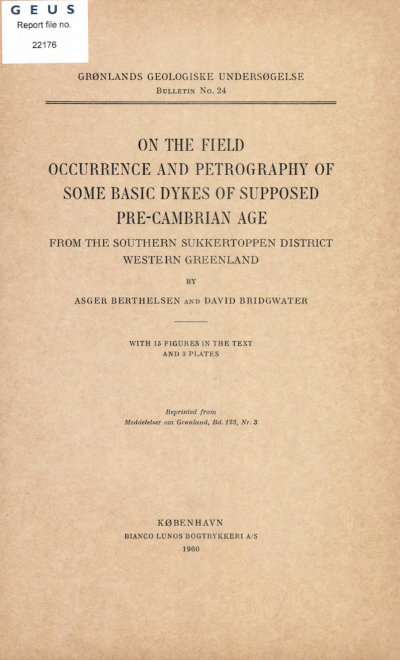On the field occurrence and petrography of some basic dykes of supposed pre-Cambrian age from the southern Sukkertoppen District, western Greenland
DOI:
https://doi.org/10.34194/bullggu.v24.6557Abstract
Within the southern Sukkertoppen district the highly metamorphosed basement rocks are traversed by several systems of basic dykes which on field evidence may be divided into an older and a younger group. The two periods of dyke intrusion are separated by the formation of an important system of NE-striking wrench faults, the Fiskefjord fauIts. The older dykes are displaced dextrally by these faults. Both groups of dykes include several sets, each with its definite and persistent trend. Petrographically the dykes may be divided into the same two main groups, an older generally orthopyroxene and olivine-bearing group and a younger pigeonitic, olivine-free group. These criteria are, however, not absolute. The older group shows, when all dykes are considered, a gradation from a very mafic rock to a more normal tholeiite, with considerable interstitial quartz, development of pigeonite instead of orthopyroxene, and an ophitic texture. These latter features are all characteristic of dykes belonging to the younger group. Within the older group, variation in mineral composition and texture seems to have been controlled by two interdependent factors, a) the order of crystallisation and b) sorting, probably under gravity. These have led to the following, seemingly anomalous relationships ; 1) dykes with a high content of early, euhedral, magnesium-rich mafic minerals show interstitial anorthite-poor feldspars; while 2) dykes with alate, iron-rich, ophitic pyroxene show more euhedral feldspars with a greater anorthite content. It is suggested that this is due to movement and sorting of crystals during the consolidation of the magma. The mafic rocks may thus have been formed by a concentration of early crystals set in a late feldspar residium; while the lighter, early feldspars solidified in a residium containing iron-rich pyroxene and a concentration of quartz and alkali feldspar. This differentiation took place prior to injection of the dykes.
Downloads
Published
Issue
Section
License
This article is distributed under a CC-BY 4.0 licence, permitting free redistribution and reproduction for any purpose, even commercial, provided proper citation of the original work. Author(s) retain copyright over the article contents.


